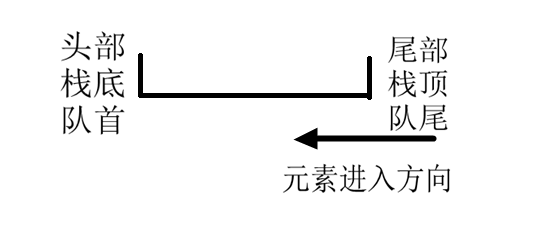496. Next Greater Element I
问题:
给定数组num2,
求num1中各数右边第一个大于它的数。
Example 1: Input: nums1 = [4,1,2], nums2 = [1,3,4,2] Output: [-1,3,-1] Explanation: For number 4 in the first array, you cannot find the next greater number for it in the second array, so output -1. For number 1 in the first array, the next greater number for it in the second array is 3. For number 2 in the first array, there is no next greater number for it in the second array, so output -1. Example 2: Input: nums1 = [2,4], nums2 = [1,2,3,4] Output: [3,-1] Explanation: For number 2 in the first array, the next greater number for it in the second array is 3. For number 4 in the first array, there is no next greater number for it in the second array, so output -1. Constraints: 1 <= nums1.length <= nums2.length <= 1000 0 <= nums1[i], nums2[i] <= 10^4 All integers in nums1 and nums2 are unique. All the integers of nums1 also appear in nums2.
解法:Monotonic stack(单调栈)
参考:单调栈&单调队列详解

对单调栈or队列的pop操作都在:尾部(stack.top & queue.back<因此得用deque,而不用queue>)
❤️ !!POINT:
- 动作:要插入新元素
- 要求:要保持栈or队列的状态为递增(递减)
- 不满足要求:则pop已有元素,再插入当前元素。
特点:
- <常用🌟 >单调递增 栈 (递减队列->可求区间最大值front)(front)<-[4,3,2,1<-top(back)
- 保存离现在cur最近index为止,最大值的递增序列
- 单调递减 栈 (递增队列->可求区间最小值front)(front)<-[1,2,3,4<-top(back)
- 保存离现在cur最近index为止,最小值的递减序列
增减性 定义:
- stack
- 单调增 栈:top->bottom 递增↗️ [4,3,2,1<-top
- while( !stack.empty() && stack.top<=cur ) pop
- stack.push(cur)
- 单调减 栈:top->bottom 递减↘️ [1,2,3,4<-top
- while( !stack.empty() && stack.top>=cur ) pop
- stack.push(cur)
- 单调增 栈:top->bottom 递增↗️ [4,3,2,1<-top
解说:
具体进栈过程 对于单调递增栈,若当前进栈元素为e,从栈顶开始遍历元素,把小于e或者等于e的元素弹出栈,直接遇到一个大于e的元素或者栈为空为止,然后再把e压入栈中。 对于单调递减栈,则每次弹出的是大于e或者等于e的元素。
- deque(固定capacity)
- 单调增 队列:front->back 递增↗️ <-[1,2,3,4]<-back
- while( !deque.empty() && deque.back>=cur ) pop_back
- deque.push_back(cur)
- 单调减 队列:front->back 递减↘️ <-[4,3,2,1]<-back
- while( !deque.empty() && deque.back<=cur ) pop_back
- deque.push_back(cur)
- 单调增 队列:front->back 递增↗️ <-[1,2,3,4]<-back
解说:
具体入队过程 对于单调递增队列,设当前准备入队的元素为e,从队尾开始把队列中的元素逐个与e对比,把比e大或者与e相等的元素逐个删除,直到遇到一个比e小的元素或者队列为空为止,然后把当前元素e插入到队尾。 对于单调递减队列也是同样道理,只不过从队尾删除的是比e小或者与e相等的元素。
可求解问题:(例如:单调增栈 [4,3,2,1<-3)需要pop 1, 2, 3
两个方向:
- 当前元素 (cur=3)
- 左边区间,第一个>cur的数 4。
- 被弹出的元素 stack.top (1,2,3)
- 右边第一个>=自己的数 cur=3。
单调队列:
- 单调减 front->back 递减↘️ <-[4,3,2,1]<-back
- 区间最大值:front
- 单点增 front->back 递增↗️ <-[1,2,3,4]<-back
- 区间最小值:front
参考例题:239. Sliding Window Maximum
本题解法:
要求每个元素右边第一个>自己的数。
有上面的思路,我们可以站在被弹出元素的角度,
使用单调递增栈,来解决。
另,求num1中对应num2中的各个元素num。
可引入unordered_map来解决对应关系。
- key:num
- value:所求下一个更大元素。
代码参考:
1 class Solution { 2 public: 3 vector<int> nextGreaterElement(vector<int>& nums1, vector<int>& nums2) { 4 unordered_map<int, int> mp;//num_value:res 5 vector<int> res; 6 stack<int> s; 7 for(int n:nums2) { 8 while(!s.empty() && s.top()<n) { 9 mp[s.top()]=n; 10 s.pop(); 11 } 12 s.push(n); 13 } 14 for(int n1:nums1) { 15 res.push_back(mp.count(n1)?mp[n1]:-1); 16 } 17 return res; 18 } 19 };




